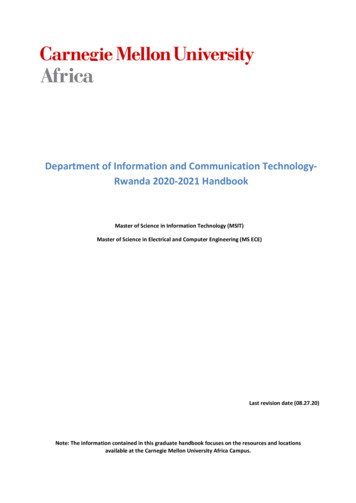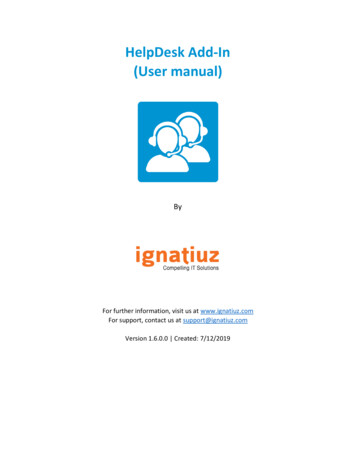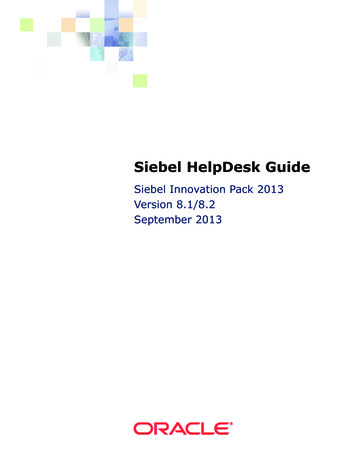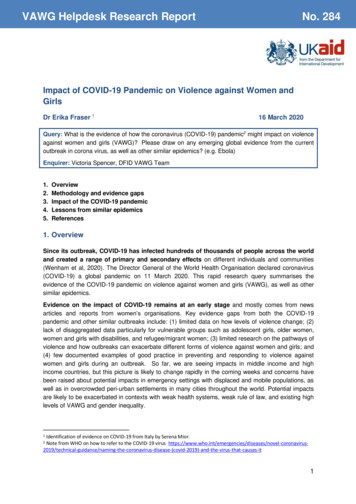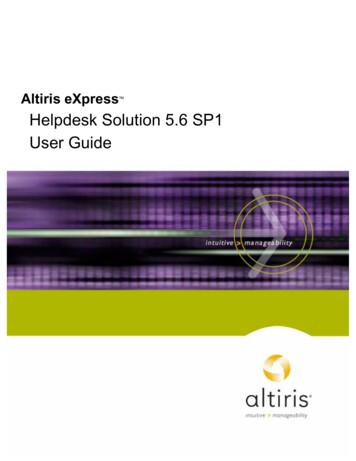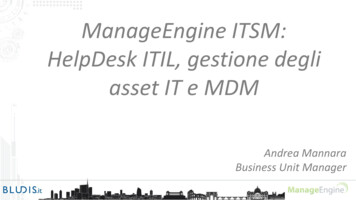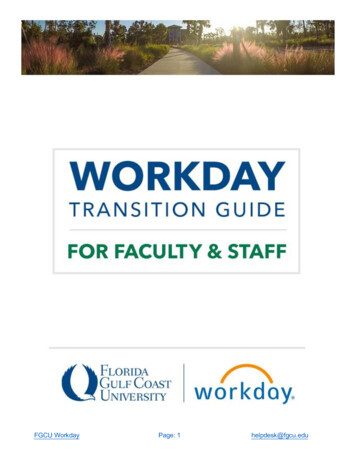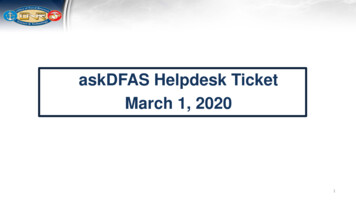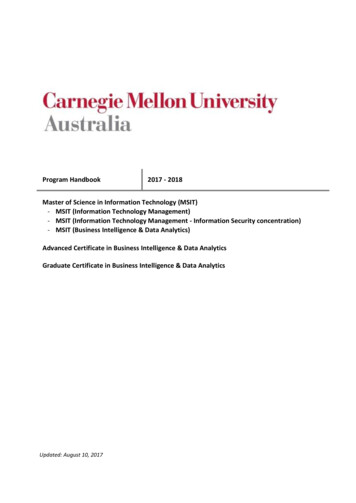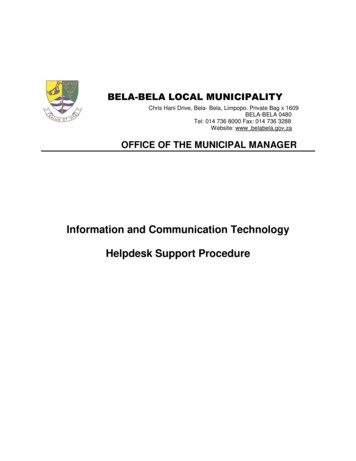
Transcription
BELA-BELA LOCAL MUNICIPALITYChris Hani Drive, Bela- Bela, Limpopo. Private Bag x 1609BELA-BELA 0480Tel: 014 736 8000 Fax: 014 736 3288Website: www .belabela.gov.zaOFFICE OF THE MUNICIPAL MANAGERInformation and Communication TechnologyHelpdesk Support Procedure
TABLE OF CONTENTS1.MANDATE OF THE ICT DIVISION2.OBJECTIVE OF THE DOCUMENT3.APPLICABILITY OF THE DOCUMENT4.TERMS AND DEFINITIONS5.REFERENCES6.ROLES AND RESPONSIBILITIES7.SERVICE SUPPORT8.HELPDESK REQUESTS9.CHECKLIST INCIDENT PRIORITY10.CHECKLIST INCIDENT ESCALATION11.CHECKLIST CLOSURE OF AN INCIDENT12.POLICY REVIEW
POLICY AUTHORITIESCompiled byD NkunaDesignationDivisional Manager ITSignatureDateSupported/Not SupportedDesignationSignatureDateApproved/Not ApprovedDesignationSignatureDateEffective DateFrom date of approval
1.MANDATE OF THE ICT DIVISION1.1The Information and Communications Technology (ICT) Division has the mandate todeliver services, support and maintain ICT infrastructure, for the Municipality torealise its mandate.2.OBJECTIVE OF THE DOCUMENT2.1 This procedure establishes a governance structure which applies to all ICT systems andinfrastructure support activities together with the acquisition of any IT hardware,software or externally sourced ICT Services.3.APPLICABILITY OF THE DOCUMENT3.1This document applies to officials from the Division: Information and CommunicationTechnology (ICT)4.TERMS AND DEFINITIONSTermDefinitionT systemsInformationeInformation systems means an interconnected set of informationrfunctionality. A system normally includes hardware, software,minformation, data, applications, communications and people.Electronic mediaresources under the same management control that shares commonElectronic media means electronic storage media including memorydevices in computers (hard drives) and any removable/transportabledigital memory medium, such as magnetic tape or disk, optical disk ordigital memory card; or transmission media internet, extranet (includesusing internet technology to link a business with informationaccessible only to collaborating parties), private networks, etc.BackupBackup means creating a retrievable, exact copy of data.RestorationRestoration means the retrieval of files previously backed up andreturning them to the condition they were at the time of backup.
5.REFERENCES5.1 International Guidelinesa. Control Objectives for Information Technology (COBIT)5.2 International Standardsb. Information Technology Infrastructure Library (ITIL)c.ISO/IEC 17799: Edition 1, 2000 – Information Technology – Code of practicefor Information Security Management5.3 National Policya. Constitution of the Republic of South Africa, Act 108 of 1996b. The Electronic Communications and Transactions (ECT) Act 25 of 2002c. National Strategic Intelligence Act 2 of 2000 applicable for South Africad. Regulation of Interception of Communications Act 70 or 2002e. State Information Technology Act 88 of 19986.ROLES AND RESPONSIBILITIES6.1The ICT Division shall ensure that the user of ICT services have access to theappropriate services to support the business functions.6.2The ICT Divison shall ensure that the procedure is followed as agreed.6.3ICT Division shall ensure that the necessary controls are in place to implement thisprocedure.6.4ICT Division aims to resolve all request for assistance on supported applicationswithin the agreed SLA.
7.SERVICE SUPPORT PROCESS7.1 Request Capture: All requests from officials will be captured and verified in thehelpdesk system7.2 Request Ticket: A request ticket will be opened in tracks with the customername,phone number and incident description7.3 Problem Resolution: IT Technicians will attempt to resolve all problems and requestsfor supported systems and applications.If the problem remains unresolved it will beescalated to the next level of support7.4 Incidents Closure: All incidents will be closed when resolution has been offered7.5 Customer Satisfaction : Surveys will be established to ensure customer satisfation7.6 Helpdesk Contact detailsHours of OperationContact Details07h30 – 16h00 Monday to FridayContact NumberEmail Addresshelpdesk@belabela.gov.zaIncident Escalation 1Dineo MotlhakaIncident Escalation 2Daniel Nkuna8.Helpdesk Requests8.1Incidentsi.Create, update and delete users in the business application systemsii.Create, update and delete users in the domainiii.Create, update and delete user folder sharesiv.Create, update and delete users in the Telephone Management System
v.Configure and install telephone handsetsvi.Addition and removal of machines from the domainvii.Install, configure and update recommended or approved softwareviii.Install and setup computer equipment and peripheral itemsix.Application software maintenance and support all requests for change8.2 Service desk Support ServicesService Desk ServicesOperating SystemsWindows 7Office ProductivityMicrosoft Office 2010Web BrowserMicrosoft Internet ExplorerAntivirus SoftwareSymantec AntivirusFile Distribution FormatAdobe ReaderApplication SystemsAll business application softwareOthersAny other applications that might be in line withbusiness operations of the municipality8.3General Supporta. ICT support shall be available to all staff on the following:8.4i.General computing adviceii.Network support servicesiii.File backup and restore servicesLevels of Supporta.ITIL uses three metrics for determining the order in which incidents areprocessed.i.Impact - The effect on business that an incident hasii.Urgency - The extent to which the incident's resolution can bear delayiii.Priority - How quickly the service desk should address the incident
b.Priority values are defines as follows:i.ii.iii.iv.c.Priority 1 low 16hrsPriority 2 normal 8hrsPriority 3 medium 4hrsPriority 4 high 2hrsITIL suggests that priority be made dependent on Impact and Urgency. Out-ofbox, this is true on incident forms. Priority is generated from Urgency andImpact according to the following table:URGENCY 1URGENCY 2IMPACT 1PRIORITY 1PRIORITY 2IMPACT 2PRIORITY 2PRIORITY 3IMPACT 3PRIORITY 3PRIORITY 4d.It should be noted that the Expected Resolution Time is merely an estimate,since resolution of the incident may require involvement of external parties whoare not bound by time estimates indicated in the table.8.5Methods of Communicationa.An incident may be reported to ICT through the following means ofcommunication:b.i.Telephoneii.Emailiii.Cell phoneiv.Walk inThe originator will report an incident to Helpdesk. If the nature of the incident issuch that the incident can be resolved immediately, such as password reset, forinstance, then the Help desk agent will attend to the incident immediately, andupdate the call logging system accordingly.
c.For second line support calls, Helpdesk will log the incident on the call loggingsystem, prioritize and assign incident to an available resource to resolve the call.d.Once the call has been logged, the originator will be issued with a call referencenumber used to follow up on progress and resolution of incident. The call willremain open on the system until the incident has been resolved.If the resolutionof an incident may require involvement of external suppliers or service providers(third line of support). In that case, the originator will be informed of sucharrangement and possible delays in the resolution of the incident.f.In the event that the incident is complicated and cannot be resolved withinreasonable time periods, or that the resolution of the incident may be prohibitivelycostly, then the originator will be advised on available options.g.Before closing any call, the Helpdesk agent must confirm with the originatorwhether the call has been resolved satisfactorily. Once the incident has beenresolved, the call logging system will be updated and the call closed.9.CHECKLIST INCIDENT PRIORITY10.1The priority of an Incident is a function of the following components:a.b.Urgency (available time until the resolution of the Incident), i.e.i.1: to 0.5 hrs.ii.2: to 2.0 hrs.iii.3: to 6.0 hrs.Degree of severity (damage caused to the business), i.e.i.1: "High" (interruption to critical business processes)ii.2: "Normal" (interruption to the work of individual employees)iii.3: "Low" (hindrance to the work of individual employees, continuation ofwork possible by means of a circumventive solution)10.2 Priority (for example in stages 1, 2 and 3): The result from the combination of urgencyand the degree of severity10.CHECKLIST INCIDENT ESCALATION
11.1The Escalation of Incidents follows pre-defined rules:a.Defined triggers for Escalations, i.e. combinations ofi.Degree of severity of an Incident (severe Incidents are, for example,immediately escalated)ii.Duration (an Escalation occurs, if the Incident was not resolved within apre-determined period, as for example the maximum resolution timesagreed within the SLAs)iii.In an ideal case this would be system-controlled triggered by customisableEscalation rules11.2Defined Escalation levels in the form of an Escalation Hierarchy:i.1st Level Supportii.2nd Level Supportiii.3rd Level Supportiv.ICT: Manager11.3 Assigned triggers to the Escalation Hierarchy (conditions/rules, which lead to theEscalation to a particular level within the Escalation Hierarchy)11.CHECKLIST CLOSURE OF AN INCIDENT12.1The following entries of an Incident Record are investigated for their integrity andcompleteness during the closure of an Incident:a.Protocol of actionsi.Person in chargeii.Support Groupiii.Time and Dateiv.Description of the activityb.Documentation of applied workaroundsc.Documentation of the root cause of the Service interruptiond.Date of the Incident resolutione.Date of the Incident closure
12.PROCEDURE REVIEWThis document must be reviewed annually or if necessary to determine if it complies withthe current security regulations. In the event that significant related regulatory changesoccur, the procedures will be reviewed and updated as needed.
instance, then the Help desk agent will attend to the incident immediately, and update the call logging system accordingly. c. For second line support calls, Helpdesk will log the incident on the call logging system, prioritize and assign incident to an available resource to resolve the call. d. Once the call has been logged, the originator will be issued with a call reference number used to .
